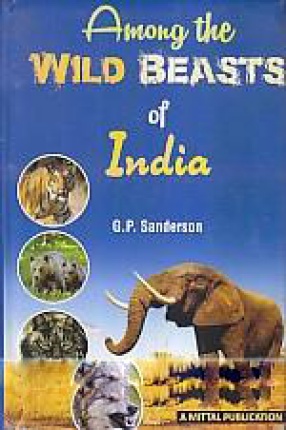Hunting is among the world’s oldest professions. From the days of caveman, who made hunting his daily pursuit for satisfaction of his food needs, to the day sportsman, who resorted to games-shooting as an exciting sport, hunting has undoubtedly been the manliest of sports. In all ages it has been the manliest of sports. In all ages it has been a royal sport and the favourite pastime of kings and warriors. The important epoch in the history of hunting dates back to the 19th century which produced some famous hunters who have lest classic accounts of wild life and their daring feats of hunting elephants –animals gifted by nature with extraordinary physical dimensions, vast energy and incredible resilience. The present emphasis on preservation of these species has rightly banned killing of the rare animals. The book thus provides a historical account of how hunting was done in the past. G.P. Sanderson, the author of the present volume, occupies a place of pride in the galaxy of great hunters of the world. By all accounts it is an immortal work and a great classic on wild beasts, specially the wild elephants. He regarded elephant-shooting as the grandest of all field sports. Sanderson landed in Madras in 1864 and left for Mysore country where he had some good friends. On reaching Mysore, he applied himself seriously to the study of Canarese, the vernacular of Mysore, so as to overcome communication difficult with the natives of the place and to develop rapport with them. He spent the next 13 years in the jungles of Mysore and Bengal. In Mysore, he stationed himself in a village known as Morlay in the Billigarangum hills where he built a house for himself and christened it as Morlay Hall. No other place was better than Morlay for diversity of game. Within a radius of half a mile of his bungalow, elephants, tigers, bears, pigs, spotted deer, bisons, samburs, antelopes and bustard were found in abundance, whilst good duck, pea-fowl, jungle fowl and snipe shooting were at his very doors. He was commissioned to try and capture herbs of wild elephants which frequently left the hills and trespassed into the adjoining cultivated fields of farmers. Sanderson prepared an elaborate and carefully laid out plan with the help of trained jungle people locally known as Kurrabas and Shalagas. After initial setbacks, his tireless efforts were crowed with success as a result of which the valuable prize of 53 elephants was secured to Mysore Government. A Similar daring feat was repeated in Bengal when Sanderson accepted the acting appointment of the Superintendent of the Dacca Kheddahs. Here the elephant catching was planned and executed into the hills tracts of Chittagong. This was a grueling feat and the dangers were as formidable as those encountered in the Mysore Jungles. He has made some significant observations after a minute study of the life and habits of elephants: Sanderson’s career as a hunter is not restricted to wild elephants alone. It embraces many other species of wild beasts like bisons, buffaloes. Tigers (Cattle lifters as well as man-eaters), wild dogs, panthers, leopards, cheetahs (hunting leopards), Indian black bears, jackals, foxes and many others. The book is replete with innumerable breath-taking stories of hunting and shooting of violent beasts. Such a remarkable epic on hunting and which records the classic account of wild life and rare-devilry of a renowned hunter, is worthy of retention in any library or book collection.
Among the Wild Beasts of India
$73.80
$82.00




There are no reviews yet.